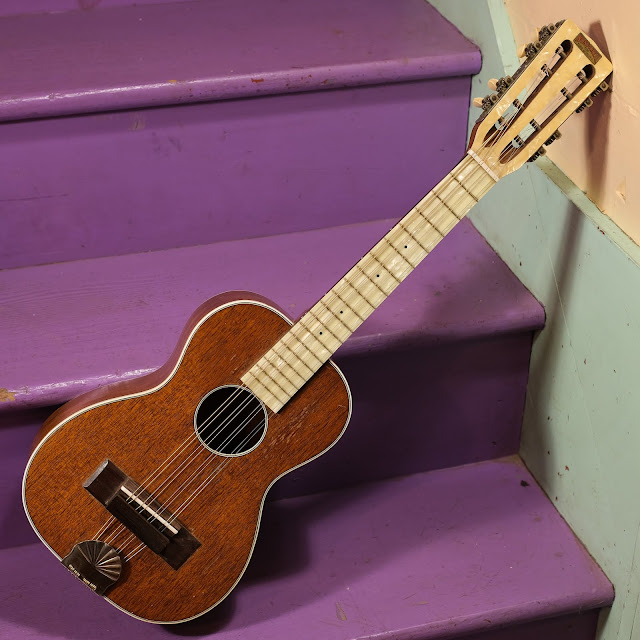1930s Harmony-made Nonpareil Tiple-to-Mandola Conversion
This little tiple visited the shop years ago via a local customer. At the time, I told him not to pursue fixing it as it had some big issues -- a ski-jumped fretboard extension, wavily-warped top, missing kerfing, unrepaired cracks, and a mis-located saddle slot -- as well as only a so-so modern conversion to mandola stringing.
Said local customer finally got me to do something about it, so I did what I could and patched its faults and ironed-out its problems. I'm still not convinced that it won't ultimately destroy itself over the next 5-10 years, but at least it's been stabilized and now plays spot-on and sounds lush.
Work included: removal and reinstall of the fretboard extension, a fret level/dress, relocation of the saddle slot farther aft, a new bone saddle, restring with thinner gauges (40w, 30w, 18w, 11), big cleats/patches for cracked and sinking areas of the top, brace reglues and extra bracing in damaged areas, a new bone nut with better string spacing, mod to the tuners to remove excess shafts/knobs, and a good setup. It plays with bang-on 1/16" action at the 12th fret and has a straight neck.
Scale length: 16 7/8"
Nut width: 1 1/2"
String spacing at nut: 1 1/4"
String spacing at bridge: 1 3/4"
Body length: 11 3/4"
Lower bout width: 8 3/4"
Upper bout width: 6 5/8"
Side depth at endpin: 3 3/8"
Top wood: solid mahogany
Back/sides wood: solid mahogany
Bracing type: ladder
Fretboard: maple, celluloid veneer
Bridge: rosewood, new
Neck feel: medium soft-V shape, flat board
Condition notes: top is wavy and deformed but stable, there are several repaired hairline cracks in the top and back, and much extra patching/cleating on the top. There's mild pickwear at the upper-bout-top, but otherwise it's pretty clean for a '30s instrument. The bridge and tailpiece are non-original but the finish is all original.
The mahogany on this tiple-dola's body is awfully-nice, orangey-brown stuff.
The headstock and maple fretboard have cream-colored celluloid veneer.
I had to fill the old saddle slot in this replacement rosewood bridge and then cut a new one 1/8" to the rear of it to get the compensation more correct. Note how I've used the small opening of the replacement tailpiece as a cheater way of using ball-end strings on a loop-end tailpiece.
I removed the extraneous, not-in-use center tuner pegs so they wouldn't rattle and drive the player crazy. Besides, now each string pair is in its own cute little cluster.















Comments